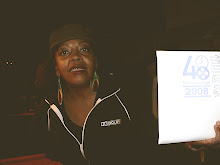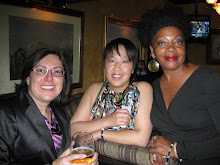Guy de Chalus, banjo teacher at the
Oakland Public Conservatory of Music’s summer camp brings storytelling to
instill the value of the instrument for cultural preservation and education.
In African traditions, he is called
a Griot – the storyteller.
One of 50 known people studying the
history of the banjo in the United States, de Chalus embraces its African
origins and the old time style of playing.
“As far as I know there are perhaps one or two others on the
west coast that play old time style banjo besides me. I haven't seen them in
these parts, I'm it,” says de Chalus.
de Chalus purchased his first banjo
for $50 from a man trying to get rid of it because he was moving out of town.
After connecting with a teacher, he eventually linked with other banjoist and
scholars who felt the need to discuss the African origin and the Black legacy of
the banjo.
There is a tremendous amount of
African American participation in banjo up through the early period of jazz.
According to “The Old–Time Herald,”
banjoist, Tony Thomas, founder of “Then and Now,” a forum for old-time music
players, scholars, and thinkers concerned for the history that pervade the
banjo and its music says, “We needed a place to express the explosion of
African American banjoists including African American Heritage Elder Etta
Baker, Taj Mahal, Alvin Youngblood Hart, Guy Davis, Otis Taylor, Sule Greg
Wilson, Don Vappie, Dr. Joan, and Rex Ellis, all known in the old-time, blues,
classic, and jazz banjo communities.
de Chalus talks to his students
about people like folklorist, Mike Seeger, (brother of Pete Seeger) being one
of the few enlightened experts who dug deeper into the roots and discovered
through stories that African Americans were involved with the banjo.
“The Earliest banjo (of sorts) was
found in what is today known as Surinam, the former Dutch Guiana.
The banjo in the American colonies
go back as early as the 17th century. An instrument transplanted by Africans to
the Caribbean during the slave trade, it was brought to the United States and
transformed through the relationship between blacks and whites in the South from
a gourd-bodied, gut-stringed instrument to a wooden-pot, steel-strung, fretted
instrument,” says de Chalus.
“The banjo is different from the
guitar, I like that it’s more high pitched, says Rachel Stovall, a student at
OPC.
“I like learning and knowing about
the roots of where it came from and that it is native to America. It is
history,” says Carolina Gonzalez Navarro, student at OPC.
“I
agree with Carolina and I love informing people that it is a native instrument
and of it’s origins in Africa. When you tell people you’re learning the banjo,
at first they assume you came from a farm or something, then after explaining
the history they become intrigued, and that makes me feel happy,” says Vinkya
Hunter, a student at OPC.
According to de Chalus, musicians
create ways to express complex ideas simply. When he teaches his students a
song, it comes with a story.
“In a story told to Mike Seeger by
Josh Thomas, an African American musician that Seeger met during his fieldwork
gathering, "Roustabout," is a tune from Thomas that researchers
believe to have alternated names. He called it "Roustabout" from one
of the words used in the opening part of the tune.” says de Chalus.
“We’re doing “Bum Ditty” to the
second string, sixteen times. I don’t know of any other kids playing that
song,” says de Chalus.
Bum Ditty is one of many ways to
understand Clawhammer technique and how it works. “It creates a rhythm that can
be summed up by saying "Bum Ditty."

























































































No comments:
Post a Comment